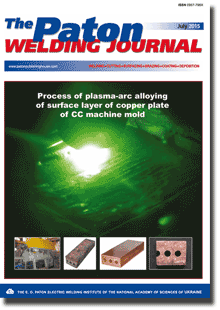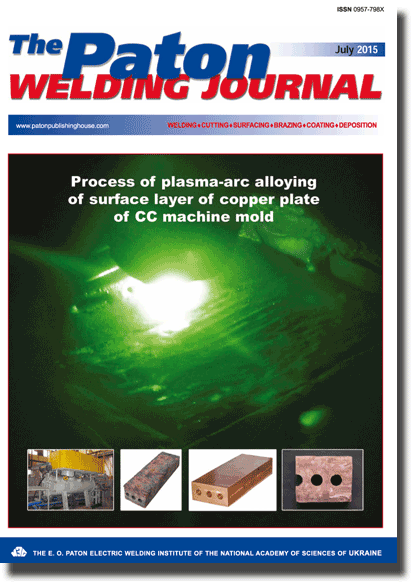| 2015 №07 (07) |
DOI of Article 10.15407/tpwj2015.07.08 |
2015 №07 (09) |

The Paton Welding Journal, 2015, #7, 47-50 pages
Evaluation of strength of joints produced using welding with concurrent brazing
V.I. Savulyak, S.A. Zabolotny And D.V. Bakalets
Vinnytsa National Technical University. 95 Khmelnitskoe Shosse, 231021, Vinnytsa, Ukraine. E-mail: vsavulyak@mail.ru
Abstract
Grounded was the rationality and the technology of producing permanent joints by combining the processes of welding and brazing using heat generated in the process of arc burning was described. The aim of the work is to establish the influence of formed brazed component on strength of the joint and structure as a whole. Developed were the methods for manufacture of pilot specimens, allowing establishing the necessary dependencies of strength of joints on type of braze material and its quantity. Namely the strength tests and processing of experimental data were performed in accordance with recommendations of GOST 28830-90. The use of programs of finite element analysis allowed determining the optimal welding conditions with concurrent brazing and the amount of braze material that can be melted. This technology can be used for repair of frames of transport machinery, damaged by cracking, by welding-on of strengthening cover plates. Also, it is rational to use the developed technology in production of frame structures. It was proved that the use of technology for producing permanent joints by combining the processes of welding and brazing using braze alloys based on copper can increase the strength of joint by one third as compared to conventional joint. 12 Ref., 3 Tables, 4 Figures.
Keywords: rame structure, transport, crack, technology, repair, strengthening, welding, brazing, strength
Received: 03.03.15
Published: 13.10.15
References
- Savulyak, V.I., Zabolotny, S.A., Bakalets, D.V. (2014) Combination of joining and brazing for repair of frames of transport facilities. Problemy Trybologii, 73(3), 17-21.
- Savulyak, V.I., Zabolotniy, S.A., Bakalets, D.V. (2013) Improvement of strengthening and repair of frame structures welding methods. J. New Technol. and Products in Machine Manufact. Technologies, 20, 189-192.
- Khorunov, V.F., (2008) Principles of brazing of thin structures from high-strength steels. Kiev: Naukova Dumka.
- Marynenko, S.Yu., Kramar, G.M. (2014) Specifics of brazing of low-tungsten hard alloys. Progres. Tekhnologii i Systemy Mashynobud., 47(1), 196-200.
- Bakalets, D.V., Savulyak, V.I. (2012) Increase in reliability and repair of metal structures of transport and agricultural machines. In: Transact. of VNAU. Series Tekhnichni Nauky, Issue 11(66), Vol. 2, 302-306.
- Petrunin, I.E., Lotsmanov, S.N., Nikolaev, G.A. (1973) Brazing of metals. Moscow: Metallurgiya.
- Lyapina, O.V. (2006) Physico-chemical processes on surface of copper alloy films: Syn. of Thesis for Cand. of Techn. Sci. Degree. Ivano-Frankivsk: V.Stefanyk PkNU.
- Kortes, A.P. (2007) Welding, cutting, brazing of metals. Moscow: Adelant.
- (1976) Technology of welding, brazing and inspection of cutter billets: Recommend of VNII. Ed. by K.P. Imshennik. Moscow: NIIMashprom.
- Ekatova, A.S. (1975) Fluxes and gas atmospheres: Refer. Book. Moscow: Mashinostroenie.
- (1989) Manual for design of steel structures to SNIP P-23-81 «Steel structures» of Kucherenko TsNIISK Gosstroya USSR. Moscow: TsITP Gosstroya SSSR.
- (1990) Strength of welded joints under alternating loads. Ed. by V.I. Trufyakov. Kiev: Naukova Dumka.
Suggested Citation
V.I. Savulyak, S.A. Zabolotny And D.V. Bakalets (2015) Evaluation of strength of joints produced using welding with concurrent brazing. The Paton Welding J., 07, 47-50.The cost of subscription/purchase order journals or individual articles
| Journal/Currency | Annual Set | 1 issue printed |
1 issue |
one article |
| TPWJ/USD | 384 $ | 32 $ | 26 $ | 13 $ |
| TPWJ/EUR | 348 € | 29 € | 24 € | 12 € |
| TPWJ/UAH | 7200 UAH | 600 UAH | 600 UAH | 280 UAH |
| AS/UAH | 1800 UAH | 300 UAH | 300 UAH | 150 UAH |
| AS/USD | 192 $ | 32 $ | 26 $ | 13 $ |
| AS/EUR | 180 € | 30 € | 25 € | 12 € |
| SEM/UAH | 1200 UAH | 300 UAH | 300 UAH | 150 UAH |
| SEM/USD | 128 $ | 32 $ | 26 $ | 13 $ |
| SEM/EUR | 120 € | 30 € | 25 € | 12 € |
| TDNK/UAH | 1200 UAH | 300 UAH | 300 UAH | 150 UAH |
| TDNK/USD | 128 $ | 32 $ | 26 $ | 13 $ |
| TDNK/EUR | 120 € | 30 € | 25 € | 15 € |
AS = «Automatic Welding» - 6 issues per year;
TPWJ = «PATON WELDING JOURNAL» - 12 issues per year;
SEM = «Electrometallurgy Today» - 4 issues per year;
TDNK = «Technical Diagnostics and Non-Destructive Testing» - 4 issues per year.


